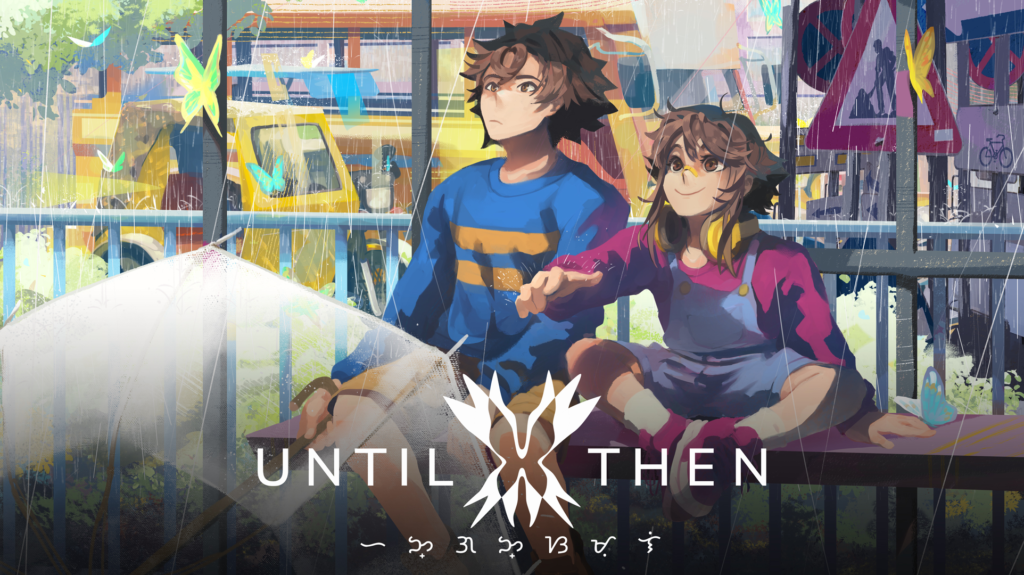
Developer: Polychroma Games
Initial release date: May 23, 2024
Platforms: PlayStation 5, Microsoft Windows, Linux, Mac operating systems
Genres: Indie game, Adventure game, Casual game, Adventure
Engine: Godot
Publishers: Maximum Games, Maximum Entertainment, Modus Games
I think it’s feasible to quit feeling depressed all the time, though I’m not sure if that’s achievable. After playing Polychroma Games’ narrative adventure game Until Then, I have come to a new realization. I could list all the emotions I felt while playing Until Then, but it would be a long list and I imagine it would be fairly unhelpful to you, dear reader. The dialogue and story meander quite a bit, but the main theme of Until Then appears to be one of grief and loss, and not in the typical way often presented by games pejoratively referred to as “walking simulators.” Until Then evoked strong emotions in me, which is something that most games don’t manage to do. But the trip it led me on was a disorganized jumble full of narrative and technological problems.
The main character of Until Then is Mark Borja. When we first meet Mark, he usually has a smug expression on his face, avoids doing his homework, and generally has a relatively carefree attitude about life. But recently, Mark has experienced events that have left him uncertain about who he is and where he wants to go in life. Firstly, a sequence of nearly simultaneous global events known as The Ruling or The Judgment, which endangered citizens of both his own and other countries. It’s impressive and frustrating how the story twists around The Ruling, which is a semi-central storyline component. It’s annoying because, despite the fact that one of the main characters is present because of The Ruling, it feels mostly unimportant for the majority of the game. This occurrence seems to be both significant and insignificant, which makes it impressive.

The pacing of Until Then is my main complaint. I don’t mind tiny or short games, as long as I’m still playing. In terms of the media as a whole, games resemble television shows or movies more than they do books. Though it isn’t strictly a visual novel, Until Then leans toward being a book. Which is all well and good, but there’s a lot of filler in the form of Mark’s relationships with all the individuals in the game, their ongoing stories, and perhaps even Mark’s lack thereof. The story of Until Then is amazing, but it gets bogged down with tiresome minigames and protracted scenes that slowly and slowly color the world around Mark.
Nevertheless, the authors of Polychroma have a gift for developing compelling and real characters. Until Then, I suppose, is set in or around the Philippines. Even though I had no cultural background there, I fit in quite well while I played Until Then. I was exposed to things in a way that made sense to me as an American, which aided in my swift adaptation. It’s very remarkable. In addition, even though the characters’ cultural background was so different from mine, I yet found them to be really sympathetic. Mark is in high school, and I wish I could have been more open with my friends about many of the topics his friends discussed and talked about when I was in high school. At first, I think I was a little jealous of Mark, but Until Then isn’t overly sweet; instead, the characters’ struggles and feelings are authentic and feel real.
The fact that the people are constantly moving contributes to the game’s sense of life, which is another small irritation I have. The characters in Until Then all have a three-frame idle motion that basically has them bouncing, taking inspiration from combat games. The pixel graphics and movement are stunning, however I didn’t find the idle animations to be very engaging. Even teenagers fidget but don’t bounce when they’re just standing around. Even still, I appreciate this as an artistic choice; it was really a small irritation. Overall, the pixel graphics is amazing, but it really shines when you see full-sized images of each character at key emotional moments. The overall effect of the art direction is breathtakingly lovely.

In order to provide for Mark and send money home, Mark’s parents are working overseas. One of the items his parents left him is a piano that his mother used to play. In order to please his mother, Mark wants to improve as a pianist. The people in Until Then really play a lot of music, which is a really enjoyable decision. Most of the time, the music is diegetic, whether it’s the children in the piano club playing their compositions or Mark attempting to sing along to karaoke. I struggled with the mini-games, so this was another source of frustration for me.
I believe it’s beneficial to vary up gaming, so I think it makes sense to incorporate some mini-games into your story journey. But, I disagree with how they are employed in Until Then. You start out by using a wooden stick to stab fish balls in the minigame. Not a problem, however a little challenging when experiencing the adventure. You never encounter a rhythm mechanic in the game, even though Mark plays the piano several times. The Yakuza/Like a Dragon rhythm game is used in video karaoke during Noche Buena, but that’s it; you’re not actually playing Mark’s piano more than halfway through the game. The rhythm game is then abruptly shown to you as Mark’s recital begins. Even if you want to give the impression that Mark makes mistakes frequently, this decision doesn’t really make sense in my opinion. It seemed inappropriate.
More importantly, the rhythm game would frequently simply stop reading my inputs. That would be quite problematic if that were the only problem. It is very annoying when your game just breaks down at a particular point. Fortunately, advancing the story doesn’t depend on performing well in the minigame. But this is only one of the game’s technical problems I encountered. I saw a screen telling me to upgrade my graphics drivers when I initially launched it. I had to update my graphics drivers before I could move past this screen. irksome. It was particularly aggravating since I was unable to use my SteamDeck to play the game for the same reasons. Since then, a patch for the game has been made available, enabling the SteamDeck version to get around this screen. Additionally, there isn’t support for ultrawide screens, thus I played the entire game in a medium-sized desktop window. That and numerous other minor technical issues marred what could have been an otherwise excellent game.

I had fun with Until Then overall, despite a few glitches during my playthrough. Polychroma crafted enduring personalities. I shall be sorely missing the characters, much as when I binge-watch a television show. The story has a remarkable and genuinely captivating number of threads that are being pulled throughout. The main plot point of Until Then is not as central to the game as it could be, as life often does. This is in contrast to many narrative adventure games. The remainder of the ensemble, especially Cath, Mark’s best friend, more than made up for my unfulfilled love for Mark as a protagonist. I would frequently get a great smile from some of the animation, especially when Cath was there.
Review Overview
Gameplay – 75%
Story – 90%
Aesthetics – 85%
Content – 78%
Accessibility – 80%
Value – 82%
Overall Rating – 83%
Very Good
Summary: Although Until Then isn’t the best narrative adventure game I’ve ever played, it’s undoubtedly one I’ll never forget. Till then, don’t give up; it’s a worthwhile experience.

